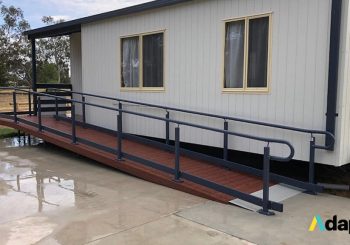Getting a wheelchair ramp installed on your property isn’t a project you can take lightly.
Getting a wheelchair ramp installed on your property isn’t a project you can take lightly. There are many different types of disability ramps that can be installed on a residential property. The type of ramp you choose will be dependent on whether you require a temporary or permanent feature, the material you opt for, as well as what your budget is. Keeping all these aspects in mind and finding a ramp that needs all these requirements can prove to be a challenging task.
There are different types of configurations available, and the layout of your property is one of the significant factors in play here as well. While it is imperative to know what you are looking for, it is even more critical to know which mistakes to avoid while building these structures. Here we take a look at some mistakes that people commonly make while constructing ramps:
1. Excessively Narrow Ramp
As mentioned earlier, the size and configuration of the ramp would be determined by the available space on your property. However, it is necessary to choose one of the right width so that it would be able to handle different wheelchair sizes. This applies to different types of layouts that may require the wheelchair user to make a sharp turn before moving onto the next length of the ramp. It is essential to make sure that the handicap ramp meets the specifications set by the DDA, to maintain maximum mobility and safety for the user.
2. Step At The Bottom Of The Ramp
This is another common mistake that can affect usability, and novice ramp installers sometimes end up constructing a step at the base of the ramp. There shouldn’t be a step at the bottom of the wheelchair ramp unless it is a tiny one. The point of a wheelchair ramp is to ensure that users have seamless access to the house or building. Sometimes, these seemingly small steps can end up making the area inaccessible, which defeats the purpose of having a ramp installed in the first place.
3. Very Steep Ramp
It is also crucial to ensure that the wheelchair ramp you choose is at a proper angle and height from the floor or ground to ensure easy use and access. In many instances, this also means the ramp might not be installed at a height similar to an adjacent staircase. Before installing this feature, it is necessary to consider how easy it would be to move a wheelchair down the length of the ramp. If it seems to be more difficult than it should be, it’s very likely there is scope for improvement.
High-Quality Disability Ramps
The proper installation of a disability ramp is key to ensuring the highest levels of safety, access, and quality of life for wheelchair users. One of the best ways to make sure but you get the kind of ramp that meets your needs is long-lasting and easy to maintain is about conducting a certain amount of research and getting help from professionals like the one at Adapta.
Our team of experts is here to provide you with all the information you need about the different types of ramps we carry. The detailed discussions we have with you will help us determine what kind of feature you are looking for and we can provide recommendations on which product would be best suited for your needs. We offer a wide variety of ramp layouts and options. You can call 1800 232 782 or contact Adapta through this form, and one of our representatives will contact you shortly.



